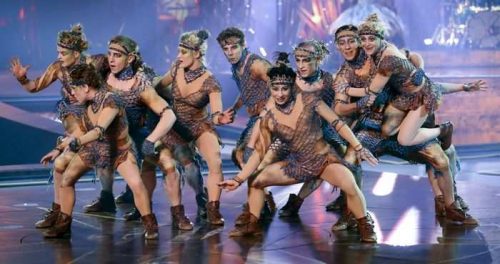Daniel Ross, Dominique Lemieux, and Émilie Therrien all have a bird’s eye view of the generation gap between the original Cirque du Soleil creation Alegria and the 2019 reboot — because all three have worked on both shows.
Ross, the director of creation for the Cirque, was the general stage manager for the touring production of Alegria in 2000, working first with the production in Biloxi, Miss., and then touring with it in Australia.
Lemieux did the costumes for the first production of Alegria way back in 1994 and she is back doing costumes for the 25th anniversary rethink that is set to have its world premiere under the Cirque big top at the Old Port on April 18. Lemieux is one of the only people returning from the original production team to do the same job a quarter of a century later.
Therrien began her circus artist career as an acrobat on that original creation of Alegria, and she toured the globe with the show for five years. Therrien has segued into working as an acrobatic coach and choreographer in recent years, and she is the acrobatic performance designer and choreographer on the new Alegria.
Ross is well aware that audiences have changed in the years since Alegria first wowed folks in 1994 (and helped launch the Cirque internationally).
“I have a feeling that if people saw Alegria as it was in ’94, because of the way the circus, theatre and multimedia arts have evolved, I think they would probably be disappointed if they saw exactly what we saw on opening night in Montreal in 1994,” Ross said.
“Everything has changed since then. People have been exposed to the circus arts a lot and I think the expectations are different than they were back then.
“So for us, the objective isn’t to present exactly the same show but to make them relive that experience again. So they sit there and get the same feeling.”
For her part, Therrien says she felt like she was floating on a cloud touring with the show back then. Now, as a coach and choreographer, she looks in admiration at today’s acrobats.
“For sure the artists have evolved over 25 years,” Therrien said. “Their level of technique has really improved compared to 25 years ago. What they can do is much stronger than 25 years ago.
“The desire to do better, to push ourselves is always there, just like it is in professional sports.
“It’s like the duo trapeze number. It’s way stronger than it was in the original show. Also we have better technology for the trapezes.
“Today, when the Cirque du Soleil takes on an artist, there is so much support available to help him or her develop to the maximum of their capacity. Twenty-five years ago, we didn’t have that kind of support. And that’s really a kind of beautiful evolution.”
As for Lemieux, she feels some things haven’t changed for Alegria over the past quarter-century.
“What I keep from the original Alegria is the message of hope,” said Lemieux, who designed the costumes for all of the Cirque du Soleil productions between 1989 and 1998, including Saltimbanco, Mystère, Alegria, Quidam, O, and La Nouba. (She also did the costumes for Céline Dion’s first Las Vegas production, A New Day.)
“Recreating Alegria with new characters for a new generation, it allows us to relive what it was like the first time,” added Lemieux. “It’s about updating those characters and to reflect on where we’ve come to and to look at our own lives today.
“When you do a revamp of an older work, you really have to read deep into the work and you have to adapt to the way people look at the world today, which is obviously different than it was 25 years ago. And the priorities have changed too in the hearts of people. I think we’ve made it more human.”
At the April 10 news event to launch the show, director Jean-Guy Legault said Alegria is “a cry from the heart from people in moments of great distress.”
Without mentioning names, he talked of a crazy person trying to impose himself on a kingdom — and it didn’t take much of a stretch to think he might be referring to U.S. President Donald Trump.
“First of all, there’s no political message,” Ross insisted. “One of the things we noticed from reading all of the notes from the creation of the original one is that the creators were often referring to things happening in the world that touched them. Things that made them sad, that made them feel that maybe the world was a bit of a dark place, and I think the need to make a show about hope and about the spirit of humankind came from that.
“So, yes, we’re anchoring ourselves in the world we live in today and we realize we’re dealing with the same kinds of things in the world that make us feel at times a bit hopeless and sad. So the need for that light is there. But I’d call it more of a social message than a political message.”
It was put to him that most of us would argue that in fact the world is a darker place now than it was 25 years ago when Alegria first premiered.
“It’s possible,” Ross said. “I hadn’t thought of it that way. But, yes, I guess it’s possible and maybe that makes (Alegria) more needed.”
{ SOURCE: Montreal Gazette }



